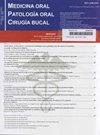Orbital blowout fractures: manifestations and missed diagnoses in 207 surgically treated patients.
IF 2.1
3区 医学
引用次数: 0
Abstract
BACKGROUND We aimed to retrospectively measure the incidence of missed orbital blowout fracture diagnosis in primary examinations of patients with surgically treated fractures, to identify the causes of the diagnostic oversight, and to describe the clinical manifestations of the fractures. MATERIAL AND METHODS A retrospective cohort of all patients with unilateral orbital blowout fractures who underwent subsequent surgical fracture reduction at the Department of Oral and Maxillofacial Diseases, Helsinki University Hospital, from January 2011 to July 2021, was gathered. Demographics, fracture type, associated injuries, clinical manifestations, reconstruction indication, diagnostic delay, and causes of fractures were analysed. For statistical analysis, Fisher's exact test, unpaired t-test, and the Wilcoxon Rank Sum were used. Significance was set at P˂0.05. RESULTS Fracture diagnosis was missed in 26 (13%) of 207 patients: in 40% of patients aged under 18 years and in 10% of patients aged 18 years or over (P=0.005). Suboptimal eye examination was found in 62% of patients with missed fracture and in 13% of those with timely diagnosis (P<0.001). Adjusted odds ratios for missed diagnosis in patients aged under 18 years versus patients aged 18 years and over was 9.3 (95% CI 2.4-35) and in patients with suboptimal versus sufficient eye examination 13.6 (95% CI 5.1-37). More common clinical manifestations in patients aged under 18 years were diplopia or restricted eye movements (P=0.005), pain in eye movements (P=0.010), nausea and/or vomiting (P<0.001), and bradycardia (P=0.014); periorbital haematoma was rarer (P<0.001). Suboptimal eye examination was involved in 62% and misinterpretation of computed tomography images in 50% of missed fractures, together explaining 85% of cases. CONCLUSIONS Orbital blowout fractures are often missed in primary examination, especially in children and adolescents, who also present with subtler clinical manifestations. While the diagnosis can be difficult, appropriate clinical and radiological examination will reveal most cases.眼眶爆裂性骨折:207 例手术治疗患者的表现和漏诊。
背景我们的目的是回顾性地测量经手术治疗的骨折患者初诊时眼眶爆裂性骨折漏诊的发生率,找出诊断疏忽的原因,并描述骨折的临床表现。材料与方法我们收集了2011年1月至2021年7月期间在赫尔辛基大学医院口腔颌面部疾病科接受后续手术骨折复位的所有单侧眼眶爆裂性骨折患者的回顾性队列。对人口统计学、骨折类型、相关损伤、临床表现、重建指征、诊断延迟和骨折原因进行了分析。统计分析采用费雪精确检验、非配对 t 检验和 Wilcoxon 秩和。结果207例患者中有26例(13%)漏诊骨折:18岁以下患者漏诊40%,18岁以上患者漏诊10%(P=0.005)。62%的漏诊骨折患者和13%的及时诊断患者的眼部检查结果不理想(P<0.001)。18岁以下患者与18岁及以上患者的漏诊调整几率比为9.3(95% CI 2.4-35),眼部检查不达标患者与眼部检查达标患者的漏诊调整几率比为13.6(95% CI 5.1-37)。18 岁以下患者更常见的临床表现是复视或眼球运动受限(P=0.005)、眼球运动疼痛(P=0.010)、恶心和/或呕吐(P<0.001)以及心动过缓(P=0.014);眶周血肿较少见(P<0.001)。62%的漏诊病例与眼部检查不当有关,50%的漏诊病例与计算机断层扫描图像误读有关,两者合计可解释85%的病例。虽然诊断可能比较困难,但适当的临床和放射学检查可发现大多数病例。
本文章由计算机程序翻译,如有差异,请以英文原文为准。
求助全文
约1分钟内获得全文
求助全文
来源期刊

Medicina oral, patologia oral y cirugia bucal
Medicine-Surgery
CiteScore
4.50
自引率
0.00%
发文量
52
期刊介绍:
1. Oral Medicine and Pathology:
Clinicopathological as well as medical or surgical management aspects of
diseases affecting oral mucosa, salivary glands, maxillary bones, as well as
orofacial neurological disorders, and systemic conditions with an impact on
the oral cavity.
2. Oral Surgery:
Surgical management aspects of diseases affecting oral mucosa, salivary glands,
maxillary bones, teeth, implants, oral surgical procedures. Surgical management
of diseases affecting head and neck areas.
3. Medically compromised patients in Dentistry:
Articles discussing medical problems in Odontology will also be included, with
a special focus on the clinico-odontological management of medically compromised patients, and considerations regarding high-risk or disabled patients.
4. Implantology
5. Periodontology
 求助内容:
求助内容: 应助结果提醒方式:
应助结果提醒方式:


